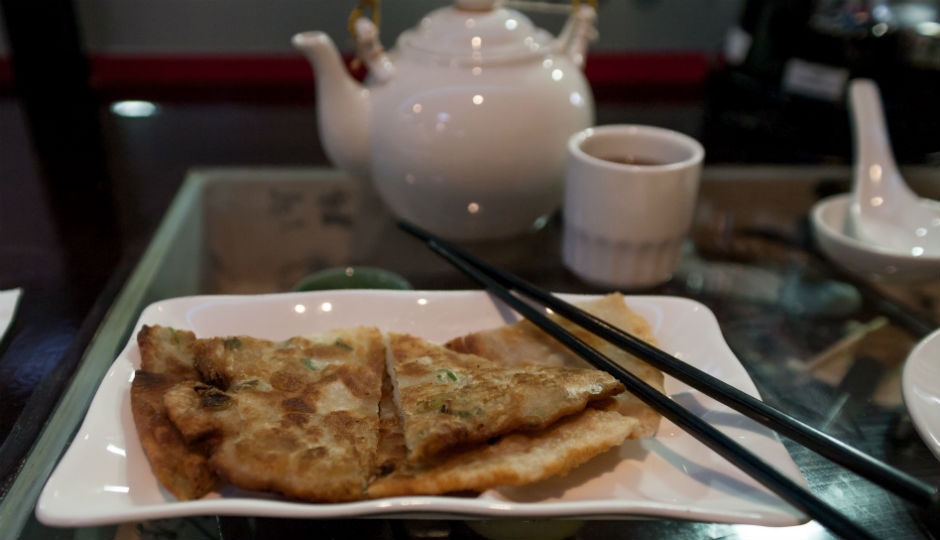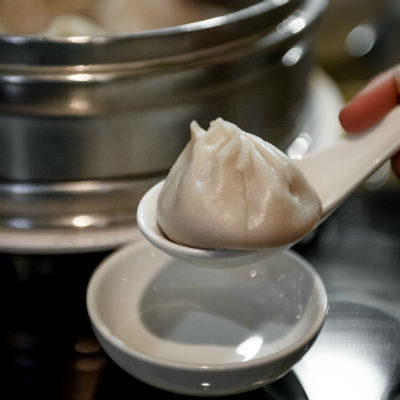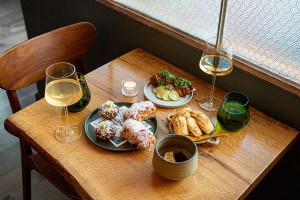Tunnel of Love and Dumplings: Tom’s Dim Sum Reviewed

The Scallion Pancakes at Tom’s Dim Sum | Photo by Claudia Gavin
There are a lot of restaurants in this town that I go to because it’s my job. There are some I find myself in because life is strange and sometimes the lesser of many evils is a plate of greasy mozzarella sticks and a hip flask of Jim Beam and Coke at 3 a.m. Others I go to because I get caught up in the excitement just like everyone else—the frenzy of the new—and want to be there to see what all the fuss is about. To weigh this particular fuss against the fuss of last week and whatever fuss might be coming along next.
And then there are places I go to because I simply can’t not go. Because something in them draws me like gravity—a comfort beyond simple sustenance, strong drinks or good company. The bar at Bud & Marilyn’s is like that. Ting Wong in Chinatown. El Rincon Criollo. This little sushi place in Suburban Station that I love just because all the sushi is made by robots and I love robots. Stargazy, which I sometimes dream about because the banoffee tart blew my mind once and I can’t ever get there often enough.
The new and improved Tom’s Dim Sum is like that. Get me within a block or two and I’ll find my course bending inevitably toward its weird, trollish location in the 11th Street tunnel on the edge of Chinatown. I’ll find excuses to go. Because I’m hungry, sure (I’m always hungry), but also because the cops go there, and cops (like cabbies, like strippers) have a sixth sense for finding the good, cheap stuff. Because when it’s raining, the water sheeting off the mouth of the tunnel as it runs beneath the Hilton and the garden of umbrellas that blooms around the crosswalk makes me feel like I’m living in the opening scene of Blade Runner. Because it serves the best scallion pancakes I’ve probably ever had in my life (a whole plate of them for less than $4, enough to make a meal of if you’re dangerously close to broke), and that’s only one of the great things the kitchen is capable of. And because going there feels like finding something hidden even if it isn’t really at all, and something special even if the menu is a mess (too long, too deep, too full of things like Chinese cabbage dumplings that even I will probably never order, and 23 different kinds of noodle soup) and the service is inept in the most well-meaning way and the space itself looks like the offspring of a one-night stand between a well-off suburban Italian bistro and a Shanghai Chipotle franchise. Plus neon.
It wasn’t always this way. Once upon a time, the restaurant that squatted in this tunnel was called Dim Sum Garden. Hard-edged, worn down and lit by unforgiving fluorescents, it looked like the kind of place that Tarantino would use to stage a final apocalyptic gunfight between armies of Triad assassins. And the food could run the gamut from shockingly good to frighteningly bad, often within the course of a single meal.
A couple of years ago, it suddenly sprouted a second location—a brand-new and shiny version on Race Street, also called Dim Sum Garden. And then the original in-the-tunnel Garden went dark for a bit before reopening under Tom Guo (the Tom of Tom’s, and one of the OG crew of the first Garden). He brought the old space back to life—gutted it, got a new kitchen and shiny wood floors and a counter laced with pink neon—and wrote an expansive, overachieving menu offering both chicken feet and General Tso’s chicken.
And so I go to the place now and it hooks me. I spend afternoons settled into a table, being offered a weird profusion of napkins and silverware by the bored waitresses and eating the soup dumplings that made the place famous in its first incarnation. They come off the dim sum menu, which is the core of what Guo does here—the best and most approachable expression of the restaurant’s heart—and they are awesome. As good as they ever were on the best nights at the old DSG, and without the wild vacillations in quality.

Soup dumplings at Tom’s Dim Sum | Photo by Claudia Gavin
They’re thin-skinned, Tom’s soup dumplings. Fragile, with pursed tops, and maneuvering them from the tin steamer tray in which they arrive to a pho spoon is a challenge, but you’ll manage. The contents (the broth, rich and sweet and bulging inside the delicate skins, and the core of minced pork and spices) are hot like lava, dangerous to the uninitiated, but everyone develops a style. I go one night with a friend who eats them whole, testing the outer temperature of them with the knuckle of one finger, choosing his moment, and then just popping the entire thing in his mouth. Living on the edge. I go for lunch with a different friend and he nips the thick tops off with his teeth, laying open the interior of the dumpling like a gift, then spikes the broth with soy and chili oil and sweet dumpling sauce and sucks the whole mess down.
I puncture the skins low, like tiny dumpling Titanics pierced by icebergs, to let some of the broth flow out into the spoon and let the whole thing cool, then knock it back like a shot.
The soup dumplings are everything you’ve ever hoped a soup dumpling would be. The product of thousands of hours of practice. But that’s just where Tom’s kitchen starts. There are two kinds of shumai on the menu—Shanghai- and Hong Kong-style. The first is filled with pork and sticky rice; the second is small and sweet and salty, perfect with a dash of soy—the shumai you’re accustomed to, only done better. The pork and chive dumplings are better fried than steamed, time in the pan giving them a crunch and texture that their steamed counterparts don’t have. Same with the Shanghai pan-fried buns—soft up top and crispy on the bottom, helping them hold together, giving them some seriousness and heft.
Every scallion pancake offered at every Chinese restaurant is a disappointment. That’s one of those bits of wisdom earned over decades of eating for a living. They’re limp or damp or gooey or tasteless, and in most cases all four of those things at the same time. But Tom’s scallion pancakes are the best item on a menu that already offers those incredible soup dumplings and delicious shumai variations and crystal shrimp dumplings that are sweet and beautiful, and skewered meats like Chinese yakitori hidden on the appetizer menu, and duck tongues in wine sauce for those who like them or just have something to prove.
Tom’s pancakes are flaky like baklava, crisp as the skin of a perfect croissant, soft inside in a way that reminds me of pierogies even if they’re nothing at all like pierogies. You should order them well done, even if saying those words out loud feels wrong to you, because this will give them a little extra color and a little extra crunch. You have to trust me on this. I learned it from a friend (the same one who convinced me to order them in the first place, after years of disappointing scallion pancakes elsewhere), and now I’m telling you. This is the way we learn the secrets of Tom’s Dim Sum—one small lesson at a time.
However you order them, they’re savory, warm, as comforting as anything in the world, gently flavored with the greenness of the scallions threaded through them but not overwhelmed by them. There isn’t a moment when I’m at Tom’s that I don’t want a plate of them on the table, and no moment afterward that I don’t wish I’d gotten an order to go. And on those rare days when I do walk out the door with an order wrapped for traveling—when I’m possessed of foresight enough to anticipate my needs five minutes from whatever moment I’m in—I only wish I’d ordered two.
More secrets: The dumpling sauce set on every table is pretty good but a little too sweet. It’s best if you mix it with a little soy. And the very best things you can eat at Tom’s (with the exception of the scallion pancakes, the soup dumplings, maybe the buns if you’re really in the mood for buns) will never show up on the menu at all. Will never show up anywhere except, sometimes, on your table, unannounced. Beautiful head-on salt-and-pepper shrimp with that numbing kick of Szechuan peppercorn. A plate of Chinese vegetables and blazing hot red chilies studded with a rough brunoise of pork. Fried rice thrown together like a staff meal—from leftovers and bits and pieces—that suddenly becomes your new standard for how good fried rice should be.
Guo does this. He tinkers. He creates. He goes in the back in the morning and makes something that would be the best dish on almost any other Chinese menu in the city, and then tells no one about it. Doesn’t advertise. He never really makes enough to put on the menu anyway. Just enough to throw down on the tables of friends and regulars, to give to those who’ve learned to ask when they sit down, Does Tom have anything special today? Is Tom working on anything in the back?
Because yeah, Tom is. Almost always.
So, all of this. All of this is the best thing about the new Tom’s—almost everything I’ve already ordered off the menu (which, yes, means mostly the dim sum), the things that will never make it onto the menu, and the promise of things that I haven’t yet discovered. What I find comforting here is the continuity—the excellence of the things I love. And what I find exciting is the idea that maybe, on any given day, I could walk in, order salt-and-pepper anchovies or duck stewed in soy sauce, and suddenly have found a new favorite. A new best thing.
There is that sense of possibility here. Of adventure waiting. Even if, on any given Tuesday or any rainy afternoon, I’m probably just going to be there comfort-eating soup dumplings and scallion pancakes at a far table, drinking hot tea and waiting to see what Tom has cooking in the back.
Stars: 3 stars–come from anywhere in the city.
Tom’s Dim Sum [Foobooz]


